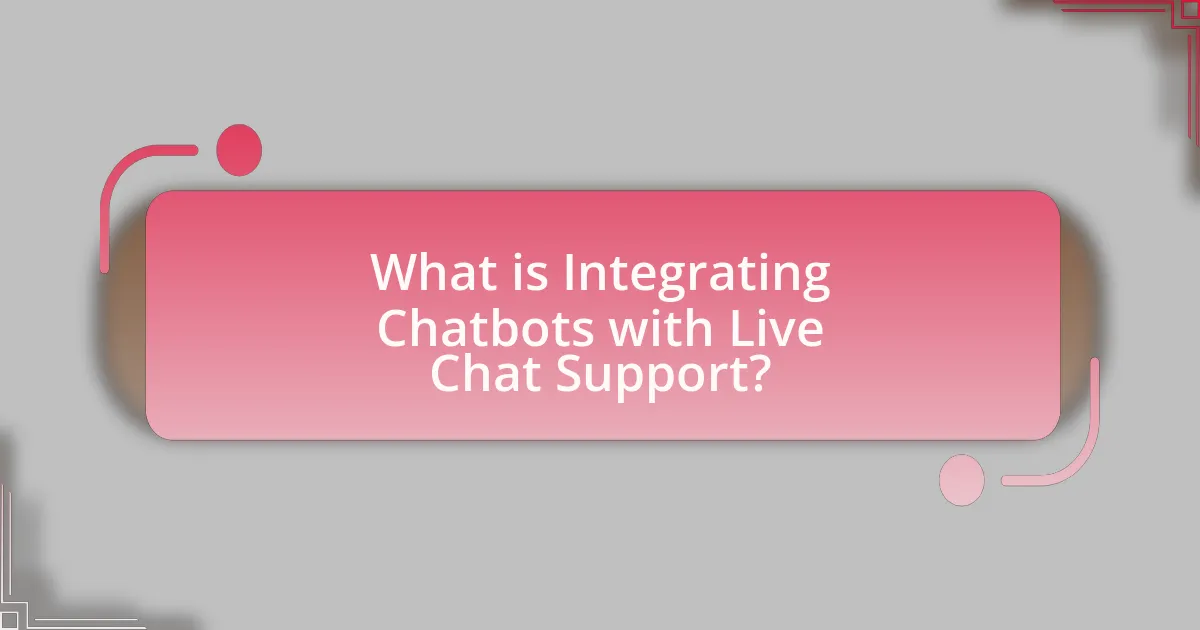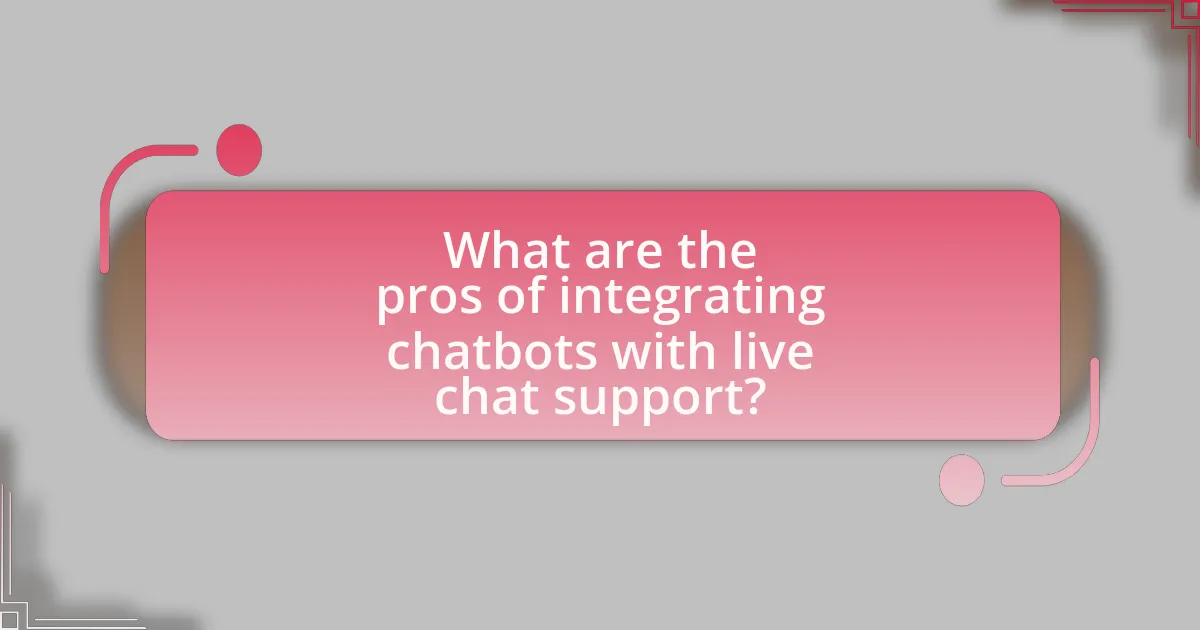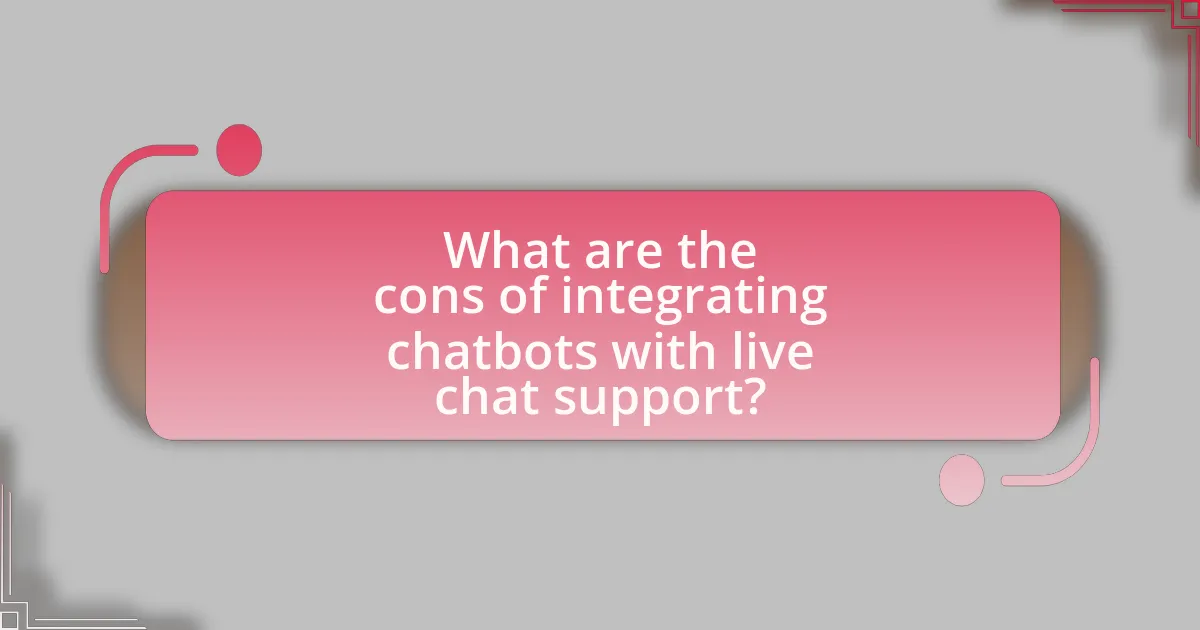Integrating chatbots with live chat support combines automated systems with human customer service representatives to enhance customer interactions. This integration allows chatbots to manage routine inquiries while live agents address complex issues, resulting in improved efficiency and customer satisfaction. Key technologies enabling this integration include natural language processing, machine learning, and artificial intelligence, which facilitate effective communication and personalized experiences. However, challenges such as misunderstandings, limited capabilities, and data privacy concerns must be addressed to optimize the benefits of this integration. The article explores the pros and cons of integrating chatbots with live chat support, highlighting operational efficiency, cost savings, and potential drawbacks in customer service quality.

What is Integrating Chatbots with Live Chat Support?
Integrating chatbots with live chat support involves combining automated chatbot systems with human customer service representatives to enhance customer interaction. This integration allows chatbots to handle routine inquiries and tasks, while live agents manage more complex issues, leading to improved efficiency and customer satisfaction. Research indicates that businesses utilizing this integration can reduce response times by up to 50% and increase customer engagement, as chatbots can operate 24/7, providing immediate assistance.
How do chatbots function within live chat support systems?
Chatbots function within live chat support systems by automating responses to customer inquiries, thereby enhancing efficiency and availability. They utilize natural language processing (NLP) to understand and interpret user queries, allowing them to provide instant answers or escalate complex issues to human agents when necessary. According to a report by Gartner, by 2022, 70% of customer interactions were expected to involve emerging technologies like chatbots, demonstrating their growing role in customer service. This integration not only reduces response times but also allows human agents to focus on more complex tasks, improving overall service quality.
What technologies enable chatbots to interact with users?
Chatbots interact with users through technologies such as Natural Language Processing (NLP), machine learning, and artificial intelligence (AI). NLP enables chatbots to understand and interpret human language, allowing for meaningful conversations. Machine learning algorithms improve chatbot responses over time by analyzing user interactions and adapting to preferences. AI enhances the chatbot’s ability to provide contextually relevant answers and engage in more complex dialogues. These technologies collectively facilitate effective communication between chatbots and users, evidenced by the widespread adoption of chatbots in customer service, where they handle millions of inquiries daily, improving response times and user satisfaction.
How do chatbots determine when to escalate to live agents?
Chatbots determine when to escalate to live agents based on predefined criteria such as user intent, complexity of the inquiry, and failure to resolve issues within a specified number of interactions. For instance, if a user expresses frustration or uses specific keywords indicating dissatisfaction, the chatbot may trigger an escalation. Additionally, if the chatbot cannot provide a satisfactory answer after a set number of attempts, it will escalate the conversation to a human agent. This approach is supported by data showing that 70% of customers prefer to interact with a live agent when their issue is complex or requires empathy, highlighting the importance of timely escalation for customer satisfaction.
What are the primary objectives of integrating chatbots with live chat support?
The primary objectives of integrating chatbots with live chat support are to enhance customer service efficiency, reduce response times, and provide 24/7 availability. By automating routine inquiries, chatbots allow human agents to focus on more complex issues, thereby improving overall service quality. According to a study by Gartner, organizations that implement chatbots can reduce operational costs by up to 30%, demonstrating the financial benefits of this integration. Additionally, chatbots can handle multiple interactions simultaneously, which increases customer satisfaction by minimizing wait times.
How does this integration enhance customer service efficiency?
The integration of chatbots with live chat support enhances customer service efficiency by automating routine inquiries and providing instant responses. This allows human agents to focus on more complex issues, thereby reducing response times and increasing overall productivity. For instance, a study by IBM found that chatbots can handle up to 80% of standard customer queries, significantly decreasing the workload on live agents and improving service speed.
What role do chatbots play in improving response times?
Chatbots significantly enhance response times by providing instant replies to customer inquiries. They operate 24/7, allowing businesses to address customer needs without delay, which is particularly beneficial during peak hours or outside regular business hours. Research indicates that companies utilizing chatbots can reduce response times by up to 80%, as they can handle multiple queries simultaneously, unlike human agents who can only manage one conversation at a time. This efficiency not only improves customer satisfaction but also streamlines operations, enabling human agents to focus on more complex issues.
What challenges arise from integrating chatbots with live chat support?
Integrating chatbots with live chat support presents several challenges, including ensuring seamless handoff between the chatbot and human agents. This handoff is critical because if not executed properly, it can lead to customer frustration and a poor user experience. Additionally, there is the challenge of maintaining consistent communication and context, as chatbots may not always capture the nuances of customer inquiries, leading to misunderstandings. Furthermore, training chatbots to handle complex queries effectively can be resource-intensive, requiring ongoing updates and adjustments to their algorithms. These challenges highlight the need for careful planning and execution in the integration process to enhance customer satisfaction and operational efficiency.
How can misunderstandings between chatbots and users impact service quality?
Misunderstandings between chatbots and users can significantly degrade service quality by leading to incorrect responses and user frustration. When chatbots misinterpret user queries, they may provide irrelevant or inaccurate information, which can result in unresolved issues and decreased user satisfaction. Research indicates that 70% of users abandon a chatbot interaction when they feel misunderstood, highlighting the direct correlation between misunderstanding and service quality. Furthermore, a study by the Pew Research Center found that 64% of users prefer human interaction when they encounter issues with automated systems, underscoring the importance of clear communication in maintaining service standards.
What are the limitations of chatbot technology in customer interactions?
Chatbot technology in customer interactions has several limitations, including a lack of understanding of complex queries, inability to handle emotional nuances, and restricted contextual awareness. These limitations arise because chatbots primarily rely on pre-defined algorithms and natural language processing, which can struggle with ambiguous language or intricate customer needs. For instance, a study by Gartner indicates that by 2022, 70% of customer interactions will involve emerging technologies like chatbots, yet many of these interactions may fail to meet customer satisfaction due to the inability of chatbots to fully comprehend human emotions or provide personalized responses. Additionally, chatbots often lack the capability to escalate issues to human agents effectively, leading to frustration for customers who require more nuanced assistance.

What are the pros of integrating chatbots with live chat support?
Integrating chatbots with live chat support enhances customer service efficiency and responsiveness. Chatbots can handle routine inquiries and provide instant responses, allowing human agents to focus on more complex issues. This integration leads to reduced wait times for customers, as chatbots can manage multiple interactions simultaneously, improving overall customer satisfaction. Additionally, data from a 2020 study by Juniper Research indicates that chatbots can save businesses up to 30% in customer support costs by automating repetitive tasks.
How do chatbots improve operational efficiency?
Chatbots improve operational efficiency by automating routine tasks and providing instant responses to customer inquiries. This automation reduces the workload on human agents, allowing them to focus on more complex issues. For instance, a study by IBM found that chatbots can handle up to 80% of standard customer queries, significantly decreasing response times and operational costs. Additionally, chatbots operate 24/7, ensuring that customer support is available at all times, which enhances overall service efficiency and customer satisfaction.
What cost savings can businesses expect from using chatbots?
Businesses can expect significant cost savings from using chatbots, with estimates suggesting reductions in customer service costs by up to 30%. Chatbots automate routine inquiries, allowing companies to handle a higher volume of customer interactions without the need for additional human staff. For instance, a study by Juniper Research indicates that chatbots can save businesses over $8 billion annually by 2024 through improved efficiency and reduced operational costs. Additionally, chatbots provide 24/7 support, minimizing the need for overtime pay and enabling businesses to allocate resources more effectively.
How do chatbots handle high volumes of inquiries effectively?
Chatbots handle high volumes of inquiries effectively by utilizing automation and natural language processing to provide instant responses. This technology allows chatbots to manage multiple interactions simultaneously, reducing wait times for users. For instance, a study by IBM found that chatbots can handle up to 80% of routine inquiries without human intervention, significantly increasing efficiency. Additionally, chatbots can learn from interactions, improving their responses over time and ensuring that they can address a wide range of questions accurately. This capability not only enhances user satisfaction but also allows human agents to focus on more complex issues, optimizing overall support operations.
What benefits do customers experience from chatbot integration?
Customers experience several benefits from chatbot integration, including 24/7 availability, faster response times, and personalized interactions. Chatbots can handle multiple inquiries simultaneously, reducing wait times and improving customer satisfaction. According to a study by Juniper Research, chatbots are expected to save businesses over $8 billion annually by 2022, demonstrating their efficiency in managing customer interactions. Additionally, chatbots can analyze customer data to provide tailored recommendations, enhancing the overall user experience.
How do chatbots provide 24/7 support to users?
Chatbots provide 24/7 support to users by utilizing artificial intelligence to automate responses and handle inquiries at any time. This capability allows them to engage with users instantly, regardless of the hour, ensuring that assistance is available outside of traditional business hours. According to a report by IBM, chatbots can handle up to 80% of routine inquiries, significantly reducing wait times and improving user satisfaction. This continuous availability is achieved through programmed algorithms that can access a vast database of information, enabling them to provide accurate responses without human intervention.
What personalized experiences can chatbots offer to customers?
Chatbots can offer personalized experiences to customers by utilizing data-driven insights to tailor interactions based on individual preferences and behaviors. For instance, chatbots can analyze past purchase history and browsing patterns to recommend products that align with a customer’s interests, enhancing the shopping experience. Additionally, they can provide customized responses and solutions, addressing specific customer inquiries or issues in real-time. According to a study by Salesforce, 70% of consumers say a company’s understanding of their personal needs influences their loyalty, highlighting the importance of personalized interactions facilitated by chatbots.

What are the cons of integrating chatbots with live chat support?
Integrating chatbots with live chat support can lead to several disadvantages, including reduced personalization and potential customer frustration. Chatbots often lack the ability to understand complex queries or emotional nuances, which can result in generic responses that do not address specific customer needs. This limitation can frustrate users who seek immediate and tailored assistance. Additionally, if chatbots are not properly integrated, they may create confusion about when to escalate issues to human agents, leading to delays in resolution. Research indicates that 70% of consumers prefer human interaction for complex issues, highlighting the importance of maintaining a balance between automated and human support.
What potential drawbacks do businesses face with chatbot integration?
Businesses face several potential drawbacks with chatbot integration, including limited understanding of complex queries, which can lead to customer frustration. Chatbots often struggle with nuanced language and context, resulting in miscommunication. According to a study by Userlike, 70% of customers prefer human interaction for complex issues, highlighting the limitations of chatbots in handling intricate customer needs. Additionally, the initial setup and ongoing maintenance costs can be significant, with businesses needing to invest in technology and training. Furthermore, reliance on chatbots may reduce the personal touch in customer service, potentially harming customer relationships.
How can reliance on chatbots lead to customer frustration?
Reliance on chatbots can lead to customer frustration due to their limitations in understanding complex queries and providing personalized responses. Customers often encounter situations where chatbots fail to comprehend nuanced language or specific requests, resulting in repetitive and unhelpful interactions. According to a study by PwC, 59% of consumers feel that companies have lost touch with the human element of customer experience, indicating a strong preference for human interaction over automated responses. This disconnect can exacerbate feelings of frustration, especially when customers require immediate assistance or have unique issues that chatbots are not equipped to handle.
What are the risks of data privacy and security with chatbots?
The risks of data privacy and security with chatbots include unauthorized data access, data breaches, and misuse of personal information. Chatbots often handle sensitive user data, making them attractive targets for cybercriminals. According to a report by IBM, the average cost of a data breach in 2021 was $4.24 million, highlighting the financial implications of such incidents. Additionally, chatbots may inadvertently store conversations that contain personal information, leading to potential violations of regulations like GDPR, which imposes strict penalties for data mishandling. These factors underscore the importance of implementing robust security measures and data encryption to mitigate risks associated with chatbot interactions.
What challenges do customers encounter when interacting with chatbots?
Customers encounter several challenges when interacting with chatbots, primarily including limited understanding of complex queries, lack of personalization, and difficulties in navigating the conversation flow. Chatbots often struggle to comprehend nuanced language or context, leading to frustration when users ask intricate questions. Additionally, many chatbots provide generic responses that do not cater to individual customer needs, which diminishes user satisfaction. Furthermore, the rigid structure of chatbot dialogues can hinder effective communication, causing users to feel stuck or unable to resolve their issues efficiently. These challenges highlight the limitations of current chatbot technology in delivering a seamless customer experience.
How can limited chatbot capabilities affect user satisfaction?
Limited chatbot capabilities can significantly decrease user satisfaction by failing to address user inquiries effectively. When chatbots cannot understand or respond to complex questions, users may experience frustration and dissatisfaction, leading to a negative perception of the service. Research indicates that 70% of users prefer human interaction when chatbots cannot resolve their issues, highlighting the importance of effective communication. Additionally, a study by Userlike found that 62% of users feel annoyed when chatbots provide irrelevant answers, further emphasizing that limited functionality directly correlates with decreased user satisfaction.
What issues arise from the lack of human empathy in chatbot interactions?
The lack of human empathy in chatbot interactions leads to user frustration and decreased satisfaction. When chatbots fail to recognize emotional cues or respond appropriately to user sentiments, it can result in misunderstandings and a sense of alienation for users. Research indicates that 70% of consumers prefer human interaction for complex issues, highlighting the limitations of chatbots in providing empathetic responses. Furthermore, the absence of empathy can damage brand loyalty, as users may feel undervalued and seek alternatives that offer more personalized support.
What best practices should businesses follow when integrating chatbots with live chat support?
Businesses should ensure seamless handoff between chatbots and live chat agents when integrating chatbots with live chat support. This involves designing chatbots to recognize when a query exceeds their capabilities and promptly transferring the conversation to a human agent. Research indicates that 70% of customers prefer to interact with a human after an initial chatbot interaction, highlighting the importance of this practice. Additionally, businesses should maintain a consistent tone and branding across both chatbots and live agents to enhance user experience. Implementing analytics to monitor chatbot performance and customer satisfaction can further refine the integration process, ensuring that both systems work harmoniously to meet customer needs.
How can businesses ensure a seamless transition between chatbots and live agents?
Businesses can ensure a seamless transition between chatbots and live agents by implementing a well-defined handoff process that includes clear communication protocols. This process should involve the chatbot gathering essential information from the user, such as their issue and account details, before transferring the conversation to a live agent. Research indicates that 70% of customers prefer to interact with a live agent after a chatbot interaction, highlighting the importance of a smooth transition. Additionally, integrating customer relationship management (CRM) systems with both chatbots and live agents allows for real-time data sharing, ensuring that agents have access to the context of the conversation, which further enhances the customer experience.
What strategies can enhance the effectiveness of chatbot interactions?
To enhance the effectiveness of chatbot interactions, implementing natural language processing (NLP) techniques is crucial. NLP allows chatbots to understand and respond to user queries more accurately, improving user satisfaction. Additionally, utilizing machine learning algorithms enables chatbots to learn from past interactions, thereby refining their responses over time. A study by IBM found that chatbots using NLP can reduce response time by up to 80%, demonstrating significant efficiency gains. Furthermore, integrating user feedback mechanisms allows for continuous improvement, ensuring that chatbots evolve based on real user experiences.










